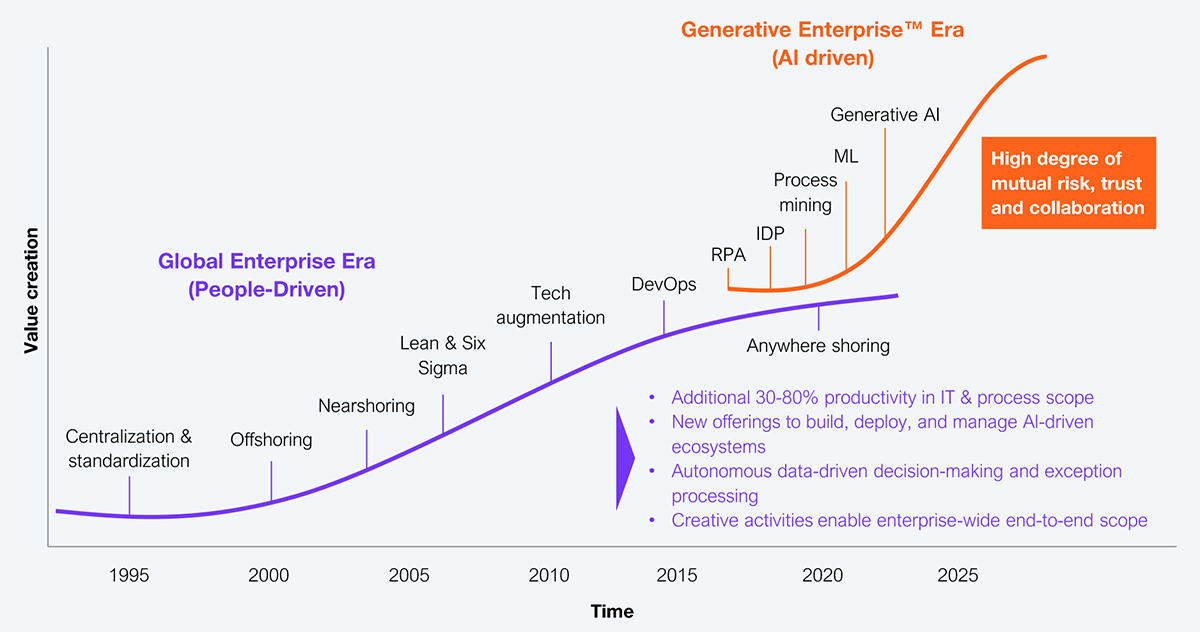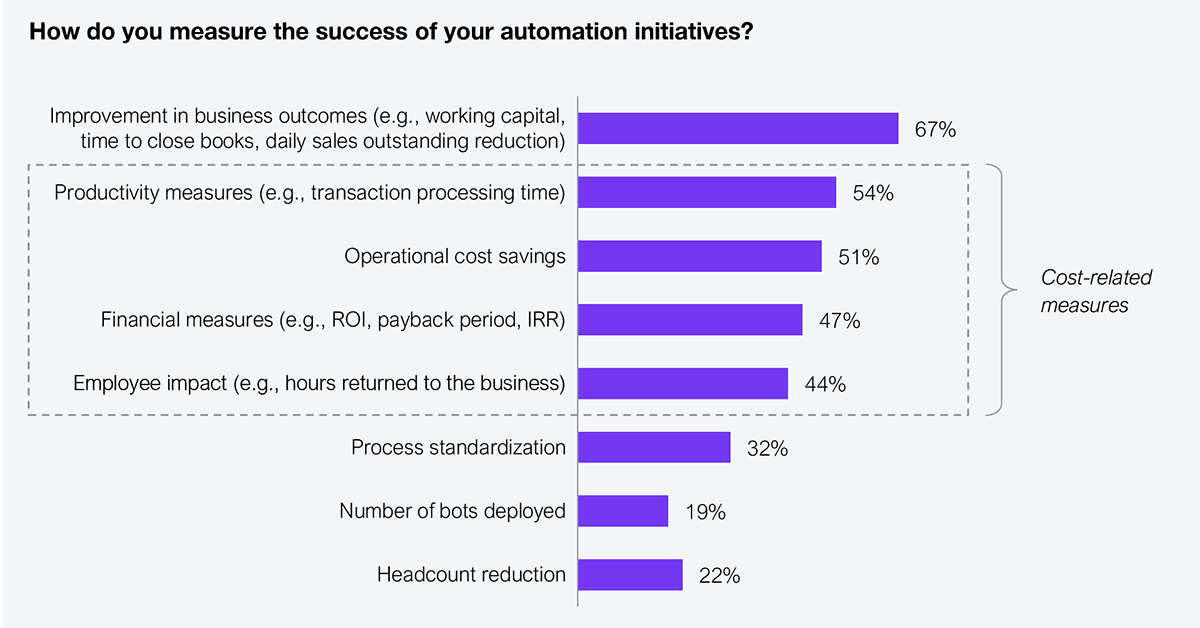The market is experiencing a significant shift toward the Generative Enterprise, which is reshaping the traditional S-curve of value creation. This evolution is characterized by a transition from basic RPA services to more sophisticated technologies such as intelligent automation and generative AI. Consumers’ rapid adoption of GenAI technologies is driving business-to-business adoption, pushing the IT and business services industry to a new S-curve of value creation
(see Exhibit 1).
Organizations that have been focusing on RPA supervision and are people-dependent must evolve into intelligent automation orchestrators. This requires leveraging various technologies such as machine learning, process mining, and GenAI to drive more comprehensive, data-driven decision-making processes. The Generative Enterprise is data and AI-led, moving from a people-focused approach to one that’s AI-driven, which is essential for driving the next wave of enterprise operations change.

Source: HFS Research, 2024
Until 2022, RPA was primarily used for task-level automation to improve productivity and reduce costs, as depicted in Exhibit 2. While focused on business outcomes, most measures were cost-related.

Source: HFS Research Automation Study, 2022
However, the market has recently realized that the potential for RPA value increases exponentially when combined with other automation tools. Today, nearly 65% of automation initiatives in business services incorporate multiple automation technologies, indicating a shift toward more integrated and intelligent solutions.
With the ascent of GenAI, the automation discussions are becoming part of a much more fundamental conversation: decoupling routine service delivery from labor arbitrage. The paradigm of people-driven labor arbitrage is running out of steam, and we are seeing the onset of a new S-curve of value creation that HFS calls technology arbitrage. The fundamental value creation lever in the legacy labor arbitrage era has been the centralization of people in a global delivery model. The fundamental value lever in the technology arbitrage era is all about architecting and orchestrating the rapidly changing technology ecosystem in line with the client’s business model. Against this background, how can intelligent automation align with shifting client demands?
HFS discussed these trends with executives at C TWO. In 2022, HFS awarded the company (known then as RPA Supervisor) Hot Vendor status because of its commitment to helping enterprises scale automation through a “single pane of glass” tooling that enabled 24×7 management of RPA portfolios. But now, it has reinvented itself into a single pane of glass orchestrator for all automation with mastery of tools such as Microsoft Power Automate. An evolved C TWO is motivated to align itself with the changing market conditions and customer requirements. As a technology-agnostic automation orchestration platform that coordinates and manages automated work, the company’s approach is intrinsically aligned with the challenge of the new economy.
C TWO stands for command and control of automation operations. The company asserts you cannot have efficient and robust operations without a centralized control system that reduces total cost of ownership—the cornerstone for an enterprise-wide digital modernization strategy. C TWO’s event-driven orchestration platform prioritizes work in real time, automates support, and doubles bot capacity. Centralized control ensures all automation works together end-to-end for stronger outcomes and better ROI. With that, organizations get workflow service-level agreements (SLA) and not just task-centric SLAs, resulting in dynamic automation scaling. Company executives translated their approach to simply, “Our goal is to assure it just works—so automation delivers on time, every time.” The key components of C TWO’s platform include:
We interviewed one of C TWO’s longest-tenured customers to gauge the effectiveness of this approach.
Discussing these trends with Carlo Guzzone, head of RPA CoE at Banca Nazionale del Lavoro (BNL), part of BNP Paribas Group, provided insights into how enterprises progress their automation journey. Through its collaboration with C TWO, BNL achieved 97% utilization of its RPA licenses, then gradually shifted to outcomes and speed of business value realization. To put this into context, HFS research has shown that utilization of RPA licenses tends to be below 50%.
BNL is a compelling example of achieving automation maturity. BNL started its RPA journey in 2017 with a leading systems integrator and Blue Prism as a technology provider, with the strategic goal of FTE reduction. However, when the demand for RPA bots strongly increased, the limitations of this contract’s technical feasibility and its singular focus on FTE savings quickly became apparent. As BNL started to scale and industrialize the deployments, the quality of the bots began to suffer. Thus, when the contract renewal approached, BNL decided to overhaul its strategy and completely change its service provider.
The revised strategy was based on three key elements. First, RPA deployments needed to be industrialized and managed at scale to support the business transformation. Second, the primary focus shifted from cost reduction to aligning business outcomes with business SLAs, replacing the goal of FTE reduction. Third, there was a fundamental change in the operating model as the RPA team was split into a run team and a design team.
At the heart of BNL’s team-splitting approach was having one team responsible for the run business and the other focusing on development. The run team leverages C TWO’s ability to intelligently orchestrate tasks and resources, ensuring optimal operations around the clock. By employing APIs for scheduling, BNL is leveraging the dynamic orchestration functionality, which utilizes AI-driven process planning and SLA-based prioritization to move beyond static scheduling methods. C TWO’s dynamic scheduling system prioritizes tasks based on their SLA requirements, ensuring that high-priority and time-sensitive tasks are completed within their specified deadlines, improving compliance and customer satisfaction. One of the differentiating features is real-time adjustments to the schedule based on current conditions and unforeseen changes. C TWO continuously monitors the RPA environment, adjusting task allocations and schedules to deal with exceptions, system load variations, and failures, ensuring the overall system remains robust.
Carlo acknowledged that calculating the business case is complex. While the initial focus was on license and maintenance cost savings, evaluating other benefits, such as quality and development model changes, is more difficult. Nevertheless, the primary outcome was a reduced ticket management workload, requiring fewer people. As such, the emphasis is on cost avoidance rather than just cost saving. It’s the difference between what enterprises spend and what they would have spent had they maintained their old methods of running RPA. For Carlo, C TWO was a critical catalyst of cost avoidance. For him, the primary objective is not about reducing costs but controlling costs and improving efficiency while scaling automation initiatives. Only through industrialized automation can organizations deliver on broader transformation goals. He estimated that their automation program drives millions in annual value, of which 30% can directly be attributed to C TWO’s orchestration. Most of C TWO’s clients have realized similar value.
The increasing complexity of operations mandates a broad orchestration of automation approaches managed increasingly by technology rather than labor arbitrage. Organizations can progress and create the value that drives innovation through an industrial operational backbone. Although the RPA era is behind us, it gave rise to the need for holistic, AI-led automation orchestration with multi-fold benefits.
Register now for immediate access of HFS' research, data and forward looking trends.
Get StartedIf you don't have an account, Register here |
Register now for immediate access of HFS' research, data and forward looking trends.
Get Started